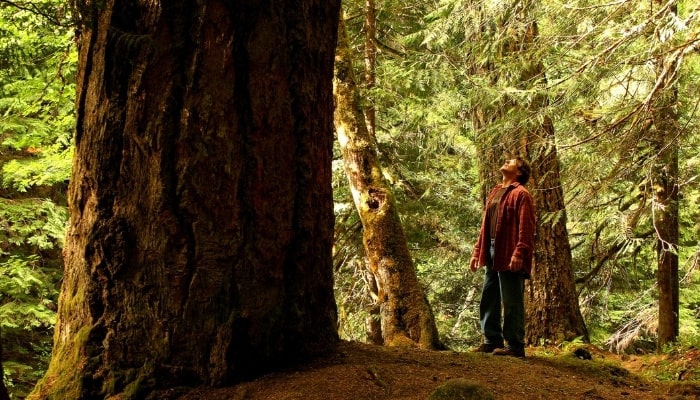As you gaze at a towering tree, you may find yourself pondering its impressive height. But have you ever paused to consider just how much such a massive tree weighs?
While trees vary in shapes and sizes, there is a formula that uses statistical measurements along with a tree’s species to calculate its approximate weight.
From the tallest to the oldest, this article explains just how to calculate the weight of a tree and all the factors that go into it.
How much does a tree weigh? While weighing a tree is not feasible, you can use a formula to find the answer. Calculate a tree’s weight by multiplying the volume and density and then adding the weight of the leaves. Different factors like height, variety, volume, density, trunk diameter, leaves, and moisture content all contribute to a tree’s weight.
Read on below to dive into each contributing factor and learn the formula for calculating a tree’s weight.
Tree Weight – Impacting Factors
As trees grow, they increase in height and girth, amassing heavy volume and size over the years. While height and girth are important factors, the tree’s species, leaves, and water-holding ability are also main factors.
Determining the listed factors below is vital to collecting the correct information to use in the formula for calculating weight.
1. Tree Height
Vertical growth is one of the main contributing factors to a tree’s weight. As it grows upward, it increases its cell mass vertically and outwardly.
It will also need to strengthen its cells with harder cell walls as it grows in height. This will help to support the added stresses, like wind and overall tree mass. A thicker and harder cell wall also increases the density of a tree.
2. Type of Tree
Depending on the tree’s variety, its overall growth habit, and its wood-cell structure, the variety of tree plays a large role in the overall weight.
Deciduous and some evergreen varieties of trees grow very dense cells, making their wood harder and stronger. Beech and hickory trees always produce hardwood. Some varieties of trees like the conifers and cottonwood always produce softwood, which is less dense.
3. Volume of Tree
Volume is one of the main variables in the formula for calculating a tree’s weight. Since a larger tree takes up a larger volume of space, the larger the volume of a tree, the more it weighs.
The volume measurement only includes the trunk because the uncertainty when calculating the volume of branches is extremely high.
4. Tree Density
Tree density is directly correlated to the hardness of the wood and is one main variable in the formula. Hardwood trees will have a higher density because their wood has formed thicker cell walls and is simply denser because of it.
Softwoods will have a lower density because their cells have thin cell walls. A large hardwood tree will weigh significantly more than a large softwood tree.
5. Trunk Diameter and Circumference
Vertical growth and the girth of a tree directly correlate to its weight. As a tree grows bigger, it must grow wider to support the height. To find the diameter of your tree, you must first find the circumference.
Use a malleable tape measure, and wrap it around the tree at approximately 55 inches from the ground. This measurement is the circumference. Divide this number by pi to find the diameter of the tree.
6. Leaves
Making up a large part of a tree’s weight, a canopy of dense, thick leaves will weigh more than a canopy of thin blade needles. When calculating the weight of a tree, the weight of its leaves is the third main variable.
Take for example the Cottonwood tree with its large green leaves and an enormous canopy. A large lush canopy like that will add a tremendous amount of weight to the tree.
In comparison, the canopy of an Olive tree will be significantly less with its small blade leaves. The leaves of an Olive tree also hold less water due to their drier climate, reducing the overall weight.
7. Moisture Content
At different times of the year, the tree will have different amounts of water and moisture within it. During a drought, it will weigh less because there is less water in the soil.
If a tree is abundantly watered, it will weigh more because it is holding more water within.
Over the winter, a deciduous tree will produce sugars and energy for the growing season ahead. It will weigh more at the end of winter because it has drawn copious amounts of sap into its limbs for storage. Once spring emerges, this sap is used as nutrients to grow leaves.

How To Calculate a Tree’s Weight
Now that all of the variables have been described, it is finally time to find the weight of a tree! The formula for calculating the weight of a tree is:
(VOLUME X DENSITY) + LEAF WEIGHT = TREE WEIGHT
Take the methods and information below for finding the variables, and plug them into the formula. This will give you a good estimate of how much your variety of tree weighs.
How To Figure the Volume of a Tree
While the volume of a tree is very difficult to calculate in the field, it can be done using the formula 𝐕 = 𝝿𝒓² x ℎ.
Take the radius of the tree squared and multiply it by pi. Then multiply that by the height to find the volume. This is the volume variable necessary for the tree weight formula.
How To Find the Density of a Tree
The density of a tree is calculated by taking the mass of dried wood and weighing it compared to green wet wood. This allows for the water to have been removed and pure wood density to be calculated.
Since this is difficult to do, it is easiest to use a resource to find its calculated density. Use the chart provided below when trying to find the wood density of the most common varieties of trees.
Tree Density Chart
How To Estimate the Height of a Tree
Finding the approximate height of a tree is necessary for calculating its volume and its total weight. There are specialized instruments for calculating a tree’s height. If you don’t have access to one, here are two additional methods for determining a tree’s height.
The easiest way to estimate the height of a tree is by using a known reference point. If a tree is growing near a two-story home, compare it to the structure. Each story is considered about 13 feet. Use other objects similarly.
If there are no objects to compare the tree to, use the American Forest method or the Indiana Division of Forestry method for determining a tree’s height.
How To Estimate Leaf Weight
Estimating leaf weight may seem like a daunting task, but there are two simple ways of finding the approximate weight of a tree’s leaves.
The first option is to remove a number of leaves from the tree, dry them, and weigh them. Then count the number of branches and count the number of leaves on one branch.
Multiply the weight of one leaf times the number of leaves on one branch. Then multiply this times the number of branches to get an approximate total leaf weight.
The second option uses the same method of collection and weighing of dried leaves.
For large trees where counting leaves and branches is nearly impossible, use a reference book or online resource to find the approximate number of leaves that will be on a healthy tree of the same size. Multiply the number of leaves times the weight of one leaf to find the weight of the tree’s leaves.
Related Questions:
What’s the Largest Tree in the World?
The largest tree in the world is a 2,100-year-old redwood named General Sherman. Its species, Sequoiadendron giganteum, is known to grow many other of the largest trees on the planet.
This tree is located in Sequoia National Park in California. This tree is the largest by volume being 275 tall and weighing an estimated 1,385 tons.
How Tall Is the Tallest Tree in the World?
The tallest tree in the world is a Sequoia sempervirnes located in Redwood National Park. Its name is Hyperion, and it reaches a staggering 380 feet tall. To compare, this enormous tree stands 1.25 times taller than The Statue of Liberty!
What Is the Oldest Tree in the World?
Pando, the oldest tree in the world, is not a single-trunked tree but approximately 48,000 quaking aspen trees. All of this 106-acre forest is connected underground by the same root system.
Estimated to be anywhere from 13,000 to 80,000 years old, this colony of trees has all grown from one initial tree with a vast underground root system.
What’s the Oldest Tree in America?
The oldest living single-trunked tree is a Basin bristlecone pine (Pinus longaeva) named Methuselah. It grows in the white mountains of California. Reaching an age of 4,853 years old, this pine has been through it all!
Other pines nearby have also been recorded to be the same age. This tree also holds the title of the oldest single-trunked tree in the world.
Are Sequoias Bigger Than Redwoods?
While these two trees are commonly confused and both grow to staggering heights, redwood trees usually outgrow sequoias by 50 to 100 feet. Sequoia trees have grown to surpass 300 feet tall while redwoods have reached heights of 380 feet tall!
How Long Does It Take a Tree To Dry Out After Cutting?
A tree drying under natural conditions may take many years to dry out! It is a rule of thumb that for every 1 inch of trunk diameter, it requires 1 full year to dry out.
Since this is extremely inefficient, trees cut down for building purposes or firewood are kiln-dried. This process can take as little as 75 minutes or up to 48 hours.
Final Thoughts
While some people may never wonder how much a tree weighs, it can be a fascinating thought that comes to many of us. While calculating the weight, you learn more about the specific tree’s variety and characteristics.
It may seem like just calculating the weight of the tree, but it is more like a full study of a single specimen. So, the next time you wonder how much a certain tree weighs, don’t hesitate to calculate it using the guide above!

